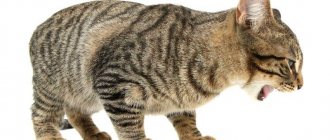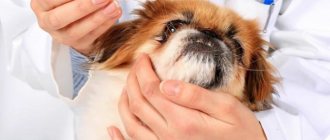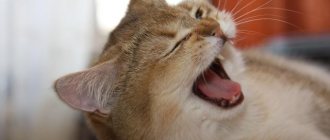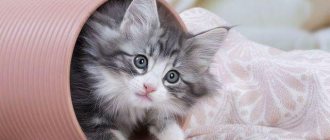Black spots in cats do not occur very often and may be the result of improper care. Sometimes such symptoms indicate disorders in the body that need to be identified as early as possible. A timely visit to a doctor will help determine the cause, and an integrated approach to treatment will eliminate the problem.
- 2 Causes and triggering factors
2.1 Why acne occurs in animals - video
- 4.1 Pharmacy and folk remedies
4.1.1 How to rid a cat of acne - video
The main causes of the disease in cats
It is quite difficult to immediately say why inflammation of the animal’s skin occurs. Therefore, it is extremely important to correctly detect the location of acne in your pet. The place where it appears will indicate the cause of the disease. Mostly in animals, blackheads appear in the area of the lips and chin. Veterinarians identify the following causes of the disease:
- Low stress resistance in the animal. After a change of environment, for example, very often there is a disruption in the functioning of the sebaceous glands.
- Insufficient hygiene, poor cleaning of the animal's chin.
- An unusual change in the functioning of the sebaceous glands, as well as in the cat’s hair follicles.
- The animal's immune system is quite weakened. Acne tends to appear at moments when the body loses all its defenses.
- If low quality plastic utensils are used for food.
These are just a few of the main causes of acne in animals, which can lead to dire consequences. The main requirement for the owner is to closely monitor the condition of his animal.
Reasons for the formation of comedones
Black spots are formed due to impaired desquamation of the skin epithelium and dysfunction of the sebaceous glands or excessive secretion.
Predisposing factors:
- Allergic reactions. The protective function of the skin is impaired.
- Parasitic diseases, as well as long-term use of immunosuppressive drugs, viral leukemia and immunodeficiency of cats, oncological diseases.
- Secondary bacterial and fungal infection.
- Bowls for drinking water and food made of low-quality or long-used plastic.
- Unbalanced or unsuitable food for the cat.
- Violation of keratinization and functioning of the sebaceous glands.
- Lack of hygiene.
- Poor living conditions.
- Genetic predisposition.
- Stress.
How to correctly identify acne in a cat
Some types of cats have a chronic form of skin disease. When treating pathologies in animals, it is possible to completely eradicate the possibility of a secondary infection, which can aggravate the animal’s condition.
There are numerous symptoms by which you can easily detect some abnormalities in a cat. If you detect them earlier , then it is possible to treat your pet in time without consequences for its health. What you should pay attention to:
- Overflow of blood vessels on the skin.
- Small acne with a white or black surface.
- A gradual increase in size of acne and its growth on the surface of the cat's face.
- Noticeable swelling near the lips.
- Vivid inflammation of ulcers and nodes in the follicles.
- Painful itching.
- Partial baldness of a cat.
The latest symptoms indicate an advanced stage of acne. The pet tries to relieve the itching by scratching the wound for a long time, which leads to discomfort and a bloody crust. Those follicles that become damaged cannot produce hair again, so the cat begins to gradually go bald.
Symptoms, distinctive features, stages
Sometimes black spots on a pet's skin form and disappear without the owner noticing. This is explained by the fact that the mustachioer does not experience any discomfort and does not scratch the problematic part of the body. Acne goes away on its own thanks to a strong immune system.
However, repeated inflammation causes significant suffering for the furry ones. An attentive owner will notice the changes that occur on the animal’s body.
In addition, the behavior of the mustache also changes. He is constantly irritated, becomes restless, begins to refuse food, and is constantly itching. External symptoms may go through the following stages:
- Initially, redness of the skin appears.
- There are more pimples, and in appearance they look like dirt on the fur.
- The affected part of the body begins to swell and increase in size.
- Gradually, ulcers and inflammation of the follicles appear.
- Crusts of pus and blood form on scratched areas.
- The last stage is the loss of fur in the affected areas.
It is important to notice dermatological problems with your pet’s skin at the initial stage. If the owner takes action in time, the patient will get rid of the pathology much faster. Relapse is caused by incorrect or delayed treatment.
What are some skin diseases similar to acne in cats?
Before starting treatment , it is necessary to accurately determine the disease in your pet. Only a veterinarian will tell you the correct diagnosis after a thorough examination of the animal in the clinic. What appears on an animal’s face can indicate not only acne, but also other skin diseases. The symptoms of many diseases coincide, it is recommended not to draw hasty conclusions. The most similar causes in terms of symptoms:
- allergy,
- dermatophytosis condition,
- scabies,
- granuloma of the eosinophilic group,
- demodicosis reaction.
In order to completely exclude or confirm a fungal or parasitic group of skin lesions, a scraping study should be carried out. It is recommended not to jump to conclusions and make a diagnosis based only on symptoms. For an accurate diagnosis, laboratory data is required.
At-risk groups
Veterinarians believe that the appearance of acne is not related to the breed, age or gender of the pet. Pathologies can be either isolated or regular, cyclical, depending on the cause of the disease.
Statistics show that castrated and sterilized animals are less susceptible to the disease, but even in this case its occurrence is not excluded.
Most often, acne appears repeatedly in cats, so it is important to completely cure the animal the first time acne appears.
In individuals with long hair, lesions may appear on the face and in the folds of the skin. The only exception is hairless cats (Sphynxes), due to greater sebum secretion than other breeds, these animals have a higher risk of acne. Careful care helps eliminate the risk of pathology.
Step-by-step treatment
Treating acne in cats at home is quite simple. The main requirements are to maintain hygiene and sterilize the area with sore skin. This is what will help reduce the risk of new onsets of the disease. Any treatment must be coordinated with a veterinarian, since the animal’s condition may worsen if the diagnosis is incorrect. But if you are completely sure that your pet is experiencing discomfort due to blackheads and acne, you should take a number of actions to avoid a growing problem:
- It is recommended that you regularly shampoo your pet on the affected area, thoroughly and gently.
- Before starting the procedure, the area should be neutralized with 3% hydrogen peroxide.
- If the animal has long hair, it is necessary to shave the hair in the affected area.
- The preparations that need to be applied to the area must dissolve the keratinized part of the skin.
- The use of antibiotics to treat acne in cats occurs only in advanced cases, when black spots on the chin begin to grow.
Home treatment should always be carried out carefully and using sterile items. Fluffy pets will try to escape from your hands in every possible way, not succumbing to your intervention.
Why do they appear?
In a cat, black spots and dots in the mouth arise due to the maximum activity of the cells that are responsible for the release of pigment. Cats are prone to pigmentation, especially red cats. A kitten may be born with black dots and spots on the tongue and palate, and then pigmentation appears on the lip, nose or in the mouth, but this is not dangerous. A genetic predisposition to staining with spots may cause them to appear. If a cat develops black spots at an older age, especially an older one, this requires consultation with a veterinarian. There are a number of factors influencing the appearance of blackheads in the mouth, namely:
- hormonal imbalance;
- poor nutrition;
- problems of the gastrointestinal tract and central nervous system;
- poor immunity.
Sometimes dark spots in the mouth disappear after eating. In such cases, you need to monitor your pet. Cats' tongues are covered with hardened nipples that help them drink, hold food, and lick fur. Perhaps the animal is gnawing on some objects, and the remains get stuck on its tongue, causing it to turn black. When eating food, the cat swallows everything along with it. In this case, there is no reason to worry.
Is it worth it to self-medicate?
Many owners use lotions and scrubs to relieve painful itching in their pet. The use of such medications can lead to poor health. Black spots on the chin should be treated only with proven remedies. Home treatments can cause allergic acne .
Treatment should be carried out by a knowledgeable person - a veterinarian. The first signs of acne in cats appear noticeably; after they are detected, it is recommended to visit a specialist. It is he who will competently conduct laboratory tests, make a diagnosis and prescribe treatment that must be followed. Any changes must be agreed upon.
Only by the size of the rash can one determine the degree of complication of the disease. When a cat's acne is at a minimal stage, local treatment of the animal is prescribed, but if the affected skin has reached large proportions, a comprehensive series of actions is applied . When treated by a specialist or at home, you should:
- do not squeeze out existing blackheads and pimples,
- adjust the proper nutrition of your pet, while eliminating all possible allergic sources that serve as irritants,
- Treatment should be carried out until the cat has completely recovered.
It is important to remember the principles of treatment - do not abuse 'folk' remedies. The pet must undergo a course of laboratory tests in order to know the diagnosis for sure. Based on the diagnosis, it will be easier to cure the cat.
Carrying out diagnostics
It is impossible to find out for yourself what kind of black marks appeared on the body of a pet. Even with some experience and knowledge, the patient’s owner will not be able to make an accurate diagnosis. To determine the nature of the skin rash, you must consult a veterinarian.
The doctor will examine the patient and find out details about the animal’s nutrition. Information about the last vaccination and deworming performed will be important for making a diagnosis. For an accurate clinical picture, diagnostic procedures can be performed:
- Scraping from the diseased area to determine the pathogenic microorganism.
- Blood sampling for serological analysis aimed at excluding other similar diseases.
- Bacteriological culture to determine the type of pathogen.
- A biopsy prescribed to identify benign or malignant neoplasms.
As a result, the veterinarian will have all the data to make an accurate diagnosis and develop a treatment regimen. The therapy prescribed by the doctor will be aimed at symptomatic elimination of skin manifestations and relief of negative consequences.
Effective remedies for rashes in pets
Before you begin home treatment for acne in cats, you need to decide on a list of necessary medications. The best treatment method would be healing shampoos with tar soap. It is these solutions that can provide maximum antiseptic and antiseborrheic effect. It is worth applying the mask regularly. Calendula tincture soaked in a gauze bandage will reduce the severity of the disease in a few days.
A drug for the treatment of acne in cats based on Furacilin is found in Perkutan. A similar prescription can be purchased at any veterinary pharmacy. The main requirement is that contact with the eyes is unacceptable .
When a secondary focus of infection occurs with the appearance of a bloody crust and abscess, antibiotics are used. For the speedy restoration of the skin, preparations with vitamins A and retinol-containing medications will help.
You should use cosmetics at home for treatment only as prescribed by a specialist. It is necessary to exclude all fatty types of food, replacing them with vitamin supplements.
Special diet
During treatment, the veterinarian will most often immediately recommend putting the cat on a special diet, eliminating any fatty and high-calorie foods from the diet. This is done in stages:
- Refusal of dry and canned food.
- Introduction of fiber and carbohydrates into the diet, usually in the form of porridges made from oatmeal and pearl barley.
- Adding vegetable or fruit stews and purees to the daily portion of food.
- Addition of vitamin complexes (ascorbic acid, vitamin A, tocopherol). It is important to observe their correct dosage. Excess can cause allergic reactions, and deficiency can cause vitamin deficiency.
Folk wisdom in the treatment of acne
Traditional medicine is always popular with supporters of natural treatment. Here are some recipes:
- Two tablets of ground furatsilin with three tablespoons of chamomile decoction. Store the solution in a cool place. Lubricate black spots on the cat’s chin 6-7 times a day.
- You can treat a problem in a cat with fresh pumpkin juice, rubbing the affected area several times a day.
- Mix a few tablespoons with dry herbs and cook in one liter of water. Lotions are made 4-5 times a day.
For various reasons, acne may appear on a cat's chin. Effective remedies will tell you how to treat this disease. The main point is that it is not recommended to apply lotions more than 10 times per day. Do not overdry the skin of your pet's face.
Acne and blackheads can occur at any age in a cat, regardless of breed, gender or weight. The disease is common among domestic animals.
Treatment for this type of disease is not so difficult. The basic rules are not to self-medicate, observe the basic requirements of cat hygiene and its nutrition should be rational.
Rash prevention
To prevent black spots from appearing on the animal’s body, it needs to be provided with good living conditions and fed only from a glass, iron or ceramic bowl. In addition, it is imperative to clean the animal, give it vitamin complexes and ensure a balanced diet.
Cleaning your pet
It is necessary to carefully monitor the cleanliness of your pet's fur, especially on the chin. To prevent contamination, you should bathe your pet with special shampoos.
Balanced diet
A balanced diet will help speed up the healing process and prevent the development of the disease. In this case, it is best to give preference to specialized products that are suitable for a specific breed. Experts recommend feeding your pet not only dry food, but also including boiled fish, chicken, eggs, carrots and grass in the diet.
Note! It is strictly forbidden to feed your pet cheap food, as it contains a large amount of preservatives and flavorings.
Balanced nutrition for cats
Vitamin complexes
A loving owner must provide his pet with a sufficient amount of vitamins. They must be contained in food, so preference should be given to special balanced feed of good quality. In addition, the animal should be systematically given vitamin complexes that will ensure the health and well-being of the pet.
Black spots on a cat's chin may indicate a pathology that occurs when the sebaceous glands become inflamed. When abnormalities appear, the animal feels well at first, but symptoms of the disease appear after a long time. The domestic cat becomes like a yard cat and is unkempt. Why this happens and how to cope with the pathology can only be suggested by a specialist who will professionally determine the cause and prescribe qualified treatment.
https://youtu.be/EwGfe9wQKAo











